Excerpts from Diane Wolfthal
Images of Rape: The "Heroic" Tradition and its Alternatives
p. 7: To most art historians the word "rape" brings to mind Poussin's Rape of the Sabines, Titian's Rape of Europa, or some such depiction in which the assailant is a Greek or Roman god or hero. This type of image, which Susan Brownmiller terms "heroic" rape, has always received considerable attention. Horst Janson's popular introductory text includes nine rape scenes; all but one are of the "heroic" type. Frederick Hartt's History of Italian Renaissance Art discusses seven, all "heroic." Not only undergraduate texts but also scholarly publications have focused on this type of representation. Even revisionist studies of the last decade such as Margaret Carroll's article on Ruben's Daughter of Leucippus and James Saslow's book on Ganymede continue this practice. The subject of "heroic" rape imagery is extremely complex and this chapter will explore only two aspects. The first section will examine how these glorify, sanitize, and aestheticize sexual violence; the second section will investigate how art historians have reinforced this construction.
The Images
Poussin's Rape of the Sabines, painted in the 1630s and today in the New York Metropolitan Museum, may well be the rape image most familiar to American art historians. It illustrates an episode from the early history of ancient Rome. The Romans, unable to obtain wives peacefully, staged a festival, invited the neighboring Sabines, and, at a signal from Romulus, each violently seized a Sabine woman. Art historians /p. 8: generally focus on Poussin's classical style or his sources in ancient art and literature. The painting is often termed "heroic" or cited as an embodiment of Poussin's belief that the highest goal of art is the depiction of noble human action. Avigdor Arikha, for example, finds the work "sublime...heroic...divine" and argues that "Poussin looked for nobility in his subject."
Certainly
in Italy, in the fourteenth through the seventeenth centuries, the incident
was viewed as a heroic, patriotic act. The Sabine women were revered as the
mothers of the first Romans. Their story adorned wedding banners, marriage
chests, and the apartments of noblewomen. The name Talassius, that of a Roman
who obtained an especially beautiful Sabine, became a wedding motto. The Sabine
legend was considered essential to the founding of Roman family life and to
the future of the nation. In the late sixteenth century it was included in
painting cycles illustrating heroic events from Roman history. 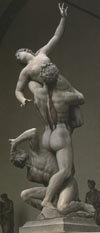 Giambologna's
statue of 1583, christened the Rape of the Sabine Woman soon after
its completion, was displayed in the main public square in Florence, the Piazza
della Signoria.
Giambologna's
statue of 1583, christened the Rape of the Sabine Woman soon after
its completion, was displayed in the main public square in Florence, the Piazza
della Signoria.
/p. 9: Poussin makes clear that the Romans are seizing women against their will. Several Romans have drawn their swords; some chase, grab, or hold the women. The Sabines' expressions are anguished. They kick, struggle, try to escape. Other figures underline the terror of the event. Infants life abandoned on the bare earth. A distraught old woman and an aged father complete the foreground frieze. Clearly Poussin is suggesting her that women, children, and the elderly pay the price for the "heroic" founding of Rome. Nevertheless, Poussin justifies the incident.
Not only does the artist reflect Roman attitudes by idealizing the crimes of their ancestors, he also accepts the Roman concept of raptus, which was quite different from the modern definition of rape. In ancient Rome, raptus meant "carrying off by force;" it was a crime of property and included thefts of all kinds. If violence was a necessary component of this crime, sexual intercourse was not. Similarly, in Poussin's painting, although the sexual aspect is implied, intercourse is not explicitly depicted. Roman law did not view the crime from the woman's point of view. Rather raptus was a crime against the woman's husband or guardian. Poussin reflects this view of rape in the major figure group on the right, which shows a Sabine father struggling against a Roman abductor.
While most of the women resist the Romans and strain toward the right, there is one, in the middle ground, who does not. Rather, she turns to her companion, apparently listening to him, as they stroll off together toward the left. Several factors draw our eye to her: her position, just left of center; the arc of empty space to her right; and the color of her robe, the same blue worn by the large Sabine women in the foreground. With this couple Poussin reminds the viewer that, as Plutarch had related, the Sabines soon accepted their husbands. This couple serves to downplay the ugliness of the event. In fact, Poussin's style --his frozen action, controlled emotional expression, and carefully ordered composition-- serves to distance the viewer from the horror of the event. This work echoes the Roman attitude, typified by Ovid's remark concerning the rape of the Sabines: "Grant me rewards such as these, [and] I would enlist for the wars."
Marriage as Rape in Renaissance Italy
These features of Poussin's Rape of the Sabine Women-- aestheticization of rape; the sanitization of the violent and sexual aspects of the theme; the focus on the point of view of the rapist and the male relatives of the victim; the suggestion of a happy ending --are typical of early modern "heroic" rape imagery. But the context in which such images are found /p. 10: varies. The three primary functions of "heroic" rape imagery produced during the fifteenth through seventeenth centuries were to elucidate marital doctrine, to serve as erotic stimulation, and to assert the political authority of aristocratic patrons.
The earliest
of these contexts to emerge was the marital. From about 1465 to 1520, "heroic"
rape themes adorned two types of art that were commissioned by leading Tuscan
families on the occasion of a son's wedding: panels on cassoni (i.e.
wooden chests) and spalliera (i.e. shoulder-high wall decorations
made for a domestic setting). The most famous example of this type may well
be Botticelli's Primavera, commissioned to commemorate the marriage
of Lorenzo di Pierfrancesco de' Medici to Semeramide d'Appiani in May 1482.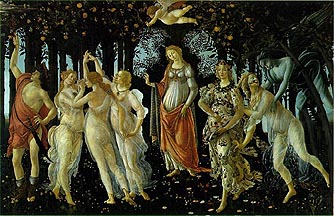
At the far right of this composition, the west wind Zephyrus tries to seize the nymph Chloris. Ovid's Fasti relates that Zephyrus raped Chloris, married her, and then transformed her into Flora, whom Botticelli depicts to the left of Chloris. Typical of "heroic" rape imagery, it depicts neither overt violence nor sexual intercourse. Indeed, Chloris seems to suffer no great harm....
/p.12: Marital paintings were decorated with a range of "heroic" rape subjects, not only the Rape of the Sabines, but also those of Europa, Io, Leda, Proserpina, and the attempted rape of Daphne. What was the message of such paintings? In part, as several scholars have shown, they functioned as lessons for the bride: they served to visualize the ideal traits that were expected of a new wife. Chief among these was chastity, but images such as the Rape and Reconciliation of the Sabines also idealized submissiveness to husband, sacrifice for family and country, and woman's role as peacemaker within the family.
One motif that appears in most "heroic" rape scenes made for a marital context, including Botticelli's Primavera..., has never been fully explored: that of the woman running frantically away from her pursuer. What was the meaning of this motif? Certainly, on one level, it indicates the woman's desire for chastity, since she flees a man who pursues her for sexual reasons. On another level, it suggests the reluctance that many Renaissance brides must have felt, since they had little say in whom they would marry. But the motif also reinforces the idea of sexual relations as a king of hunt....
/p. 15: Roman culture continued to link marriage and "heroic" rape. A sarcophagus, dated shortly before the second century B.C.E. and well known /p. 16: in Renaissance Florence, shows the rape of the daughters of Leucippus by the Dioscorides on the front and their marriage on the sides. On the main relief a frightened companion of the victims marks the center of the relief. The seizure of the women is shown in two groups, to either side. Typical of "heroic" rape imagery, the Diocorides are not shown in the act of sexual intercourse, nor do they use weapons. But the victims' thrashing heads and flailing arms make clear their lack of consent....
/p. 17: The sides of the sarcophagus reveal the "happy ending" of the sotry: the marriage of the Diocorides to the daughters of Leucippus. The women, now dressed in bridal veils, calmly accept their fate. As in so many images of "heroic" rape, they have apparently suffered no great harm. All evidence of sexuality is eradicated in the wedding scenes. Although on the front, the women's drapery had slipped down, revealing their breats, on the sides of the sarcophagus, their bodies and hair are decorously covered....
"Heroic" Rape as Erotica
Guido Ruggiero has concluded that beginning in the High Renaissance, there arose an "aversion to marriage and a common celebration of sexual freedom for males beyond the morality of society and religion. Per- /p. 18: haps it is no coincidence then that after 1500 a second type of "heroic" rape image developed, which functioned as erotica for the male viewer.
 Poems
published on the occasion of the unveiling of Giambologna's Rape of the
Sabine Woman imagine young men lured to the statue by the Sabine woman.
Onr poet, Bernardo Davanzati, writes: "This, my Giambologna, is your
Sabine from whom you burned with desire...."
Poems
published on the occasion of the unveiling of Giambologna's Rape of the
Sabine Woman imagine young men lured to the statue by the Sabine woman.
Onr poet, Bernardo Davanzati, writes: "This, my Giambologna, is your
Sabine from whom you burned with desire...."
There were
two primary ways in which "heroic" rape images were constructed
to appeal to the erotic tastes of the male viewer. Some artists simply
disregarded the standard literary versions of the myth and depicted the rape
as if it were a seduction. For example, Correggio's Jupiter and Io, painted in the early 1530s for Frederigo II Gonzaga, then marquis of Mantua,
falls into this category. Best known for its sensual qualities, the canvas
shows Jupiter, disguised as a dark cloud, embracing Io. Commissioned as one
of a series of canvases depicting the erotic pursuits of the Roman gods, its
rich tones, hazy atmosphere, and the soft warm flesh of a beautiful woman
contribute to its sensual mood.
painted in the early 1530s for Frederigo II Gonzaga, then marquis of Mantua,
falls into this category. Best known for its sensual qualities, the canvas
shows Jupiter, disguised as a dark cloud, embracing Io. Commissioned as one
of a series of canvases depicting the erotic pursuits of the Roman gods, its
rich tones, hazy atmosphere, and the soft warm flesh of a beautiful woman
contribute to its sensual mood.
Susan Brownmiller observed that goddesses and mortal women raped by ancient Greek or Roman gods or heroes "rarely suffered serious consequences." Indeed, when we look at Correggio's painting, we feel no /p. 19: pain, terror, or revulsion. Although contemporary marital paintings show Jupiter chasing a terrified Io, Correggio shows no violence. This contradicts Ovid, who related that Jupiter "caught the fleeing maided and ravished her." Correggio instead depicts Jupiter as a tender lover whom Io welcomes. Her head rolls back in a swoon; her lips part in ecstasy; her /p. 20: arms embrace the god. Correggio's image, like so many "heroic" rape depictions, serves to blur the distinction between an erotic interlude and rape. Typical of "heroic" rape imagery, the artist avoids any explicit depiction of sexual intercourse. Rather, Correggio reinforces ancient Roman attitudes by idealizing the rape. The painter, in search of an erotic subject, chose a "heroic" rape myth and then subverted its narrative so that the victim is constructed as a willing lover.
Other eroticized "heroic" rape images reveal an undercurrent of violence. For example in Giambologna's statue, the Sabine woman pulls away from her Roman assailant, attempting to free herself from his grasp. Her arms flail in protest; her brow is furrowed; her downturned mouth is opened as if to cry out. Unlike Io, she is clearly not a willing lover. Cinquecento viewers would have interpreted this sculpture as a rape scene. Rape victims were required to prove in court that they had resisted and cried out -- precisely the actions of the Sabine woman. Furthermore, a poem written on the occasion of the unveiling of the statue notes that its Roman violator would have been arrested for a criminal offense hat his action occurred in sixteenth-century Florence....
/p. 22: The Political Context of Eroticized "Heroic" Rape Imagery
"Heroic" rape imagery was often multivalent. Marital images at times served an erotic function, as a glance at the Primavera suggests, and erotic representations often operated on a political level as well. Recent scholarship has established that class was a determinant factor in patronage patterns for erotic images of "heroic" rape. In particular, princes throughout Europe asserted their political authority through such works.
Charles Hope
has noted that Titian produced two types of erotica. Some, such as his Rape
of Europa 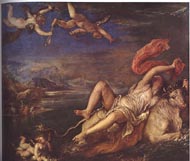 ,
painted for Philip II over the years 1559-62, showed mythological subjects.
These were viewed as "high" art and commissioned by aristocratic
patrons who lived outside Venice. Other erotic paintings, lacking a classical
veneer, were produced for less patrons, generally Venetian. All across Europe,
from Florence to Prague, courtly patrons commissioned "heroic" rape
imagery; this was an activity that was expected of a prince....
,
painted for Philip II over the years 1559-62, showed mythological subjects.
These were viewed as "high" art and commissioned by aristocratic
patrons who lived outside Venice. Other erotic paintings, lacking a classical
veneer, were produced for less patrons, generally Venetian. All across Europe,
from Florence to Prague, courtly patrons commissioned "heroic" rape
imagery; this was an activity that was expected of a prince....
/p. 23: Why did this type of erotica appeal to the upper classes? Contemporary sources make clear that "heroic" rape imagery aroused not only sexual desire but also feelings of omnipotence. Ginzburg traces one root of this idea from ancient Rome to sixteenth-century Italy. In Terence's The Eunuch, a young man, upon viewing a painting of Jupiter and Danaë in the home of a woman he loves, becomes sexually aroused. As a voyeur observing an erotic image, he imagines himself in Jupiter's place. Merely an ordinary man ("a mere manikan," as he describes himself), through his gaze he is able to identify with the most powerful of gods. This identification is not purely sexual; the young man remarks on the god's tremendous power, he "whose thunder shakes the highest realms of heavens." Through sexual intercourse the young man feels closer to Jupiter's immense power.... Through the male viewer's identification with a divine or heroic assailant, eroticized paintings of "heroic" rape imagery served to arouse feelings of moth sexual excitement and omnipotent power....
Similarly,
in the early modern period, as Margaret Carroll has shown, forcing a woman
to submit sexually was viewed as parallel to dominating one's subjects politically.
Citing a wide range of sources, Carroll has convincingly shown that aristocratic
rulers identified with Roman gods and heroes who possessed absolute power
and operated above the law. Relian on action, not thoughtful reflection, these
classical figures were able to violently subjugate others. Although "heroic"
rape imagery at times suggests the destructive results of this subjugation,
it nevertheless constructs the hero as an admirable figure, virile, strong,
and courageous, whose fame rests in part on his acts of sexual violence. Walter
Friedlaender remarked that Giambologna's statue "served to exemplify the much admired patriotism and resolutions of early
Rome that permitted any act, even a ruthless or barbarous one, which would
assure the future of the nation."
"served to exemplify the much admired patriotism and resolutions of early
Rome that permitted any act, even a ruthless or barbarous one, which would
assure the future of the nation."
/p. 24: While
most "heroic" rape paintings belonged to princes' private collections,
at least one, Giambologna's Rape of the Sabine Woman, was displayed
publicly. Grand Duke Francesco de' Medici ordered it installed in the Loggia
dei Lanzi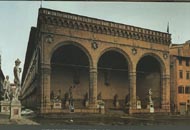 , which is situated on the south side of the main square in Florence, the
Piazza della Signoria, and at right angles to the Palazzo Vecchio, the seat
of political power. Here the sculpture publicly proclaimed the power of the
Medici dynasty. But Carroll has also proposed that the statue suggested "the
dominion" all men enjoyed "over the women in their own homes."
In this way, the sculpture "helped create an empathetic bond between
ruler and ruled that span[ned] class divisions." Clearly feelings of
omnipotence were not confined to aristocratic circles. Rather, "heroic"
rape imagery could arouse similar feelings in the ordinary male citizen of
Florence. Indeed, this thirteen-foot-high sculpture showing a man seizing
a woman against her will was greeted with tremendous enthusiasm in sixteenth-century
Florence, as the numerous copies and poems in its honor demonstrate....
, which is situated on the south side of the main square in Florence, the
Piazza della Signoria, and at right angles to the Palazzo Vecchio, the seat
of political power. Here the sculpture publicly proclaimed the power of the
Medici dynasty. But Carroll has also proposed that the statue suggested "the
dominion" all men enjoyed "over the women in their own homes."
In this way, the sculpture "helped create an empathetic bond between
ruler and ruled that span[ned] class divisions." Clearly feelings of
omnipotence were not confined to aristocratic circles. Rather, "heroic"
rape imagery could arouse similar feelings in the ordinary male citizen of
Florence. Indeed, this thirteen-foot-high sculpture showing a man seizing
a woman against her will was greeted with tremendous enthusiasm in sixteenth-century
Florence, as the numerous copies and poems in its honor demonstrate....
/p. 25: It
is striking that no woman artist, to my knowledge, produced a "heroic"
rape image during the Renaissance or Baroque periods. But Artemisia Gentileschi
did paint images of sexual violence, such s those of Susannah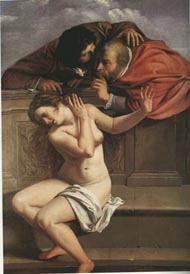 ,
which, Mary Garrard has demonstrated, constructed Susannah quite differently
from those by contemporary male artists.
Expressing a subversive voice, the artist sympathized with the victim, and
movingly depicted her vulnerability and the anguish of sexual violence. Inverting
the usual reading of such legends, she refused to show Susannah as a seductress
or an object of sexual desire....
,
which, Mary Garrard has demonstrated, constructed Susannah quite differently
from those by contemporary male artists.
Expressing a subversive voice, the artist sympathized with the victim, and
movingly depicted her vulnerability and the anguish of sexual violence. Inverting
the usual reading of such legends, she refused to show Susannah as a seductress
or an object of sexual desire....
[A] glance at the canonical "heroic" rape images by Poussin, Titian, Correggio, and Giambologna supports Helen Hazen's assertion that "rape is a significant and often even a grand act in myth and literature [although] it is generally a very sordid and terrible one in life." Images have power; they don't simply reflect reality, but can influence attitudes and this way affect actual events. To cite but one example, the blurring of seduction and rape, which we explored in Correggio's Io, was not confined to the cultural domain but spilled over into the legal arena. In a rape trial that took place in Venice in the year 1477, testimony established that Francesco Papaciza had pursued Ursia for some time /p. 26: without success. Finally Francesco informed her that "either by love or by force I want you to give yourself to me." Guido Ruggiero concludes "it is clear that wooing and threats went hand in hand at times." This same phrase, "per forza or per amore" voiced in Venice in 1477 crops up at the end of the period under discussion. In seventeenth-century Rome, at the same time and place that produced Poussin's Rape of the Sabines, court transcriptions of a rape case reveal that men still acted on the principle that they would have their way "by force or by love." Images of "heroic" rape served to reinforce such attitudes....
The images that we have explored in this section lie at the center of Western culture. These paintings and sculptures of "heroic" rape --displayed in the homes of leading families, at aristocratic courts, even in city squares-- demonstrate that the fantasy of erotic domination permeated early modern society. Certainly, as we have seen, many "heroic" rape images served as a sign for something else -- for marriage or politics, for women leaving home or men feeling powerful. But they were also, on some level, about "real rape," to use Susan Estrich's term.
The Renaissance is often praised as a time when culture was reborn, when Europeans looked to ancient Greco-Roman civilization for enlightened inspiration. Indeed, the rape images that we have examined today are deeply influenced by classical ideas. But many of these ideas are unacceptable to us today --that sexual relations are like the hunt; that marriage can be equated with rape; that when seduction fails, violence may be employed; that aggression against an unwilling partner enhances eroticism; that in the end the rape victim will be happy with her assailant.
These works --by Poussin, Titian, Correggio, and Giambologna-- are key monuments in the canon of art history. They construct rapists not as depraved sex maniacs, nor even as ordinary men who have gone astray, but rather as the very gods and heroes of classical civilization, whose acts of violence they exalt. These acts, and the attitudes that underlie /p. 27 them, are glorified by the most esteemed Renaissance and Baroque artists and still resonate in today's discourse on rape. If we simply admire these works for their incredible beauty and power, while ignoring their full range of meanings, then we are gaining only a partial understanding of these important monuments, and we are permitting past misconceptions about rape to live on. Early modern artists glorified, sanitized, and aestheticized "heroic" rape, and modern art historians, as we shall see, have unfortunately reinforced that construction.
Rewriting Rape Imagery:
/p. 28: This section will explore how the language of modern art historians has framed the interpretation of images of "heroic" rape. It will explore scholarly publications but will also examined textbook treatments of such scenes, since these generally express accepted opinion, and, as Bradford Collins recently noted, "these writings constitute the student's first and therefore formative experience with art history." The history of writings about "heroic" rape imagery is extremely complex; this section will focus on the way art historians have discussed three interrelated issues: Do these images depict rape? Is the victim willing? And, is she pretty?
Do these Image Depict Rape?
Not only artists but art historians have traditionally sanitized and aestheticized rape. Although "heroic" rape myths involve violent seizure of women, or, more rarely, men, for sexual purposes, this is generally glossed over. The words most commonly used by authors to describe the subject --"abduction," "amorous advances," "pursuit," "love," and "seduction" -- do not accurately characterize the relations between aggressor and /p. 29 victim in these images. Furthermore, these terms are not synomymous with the word rape, which is so often used in titles of "heroic" rape imagery, but this disjuncture between title and description is generally unexplored. In part, this is because art historians have traditionally adoptyed classical ideas about "heroic" rape. In Ovid's Metamorphoses, a work that was widely read by Renaissance humanists and modern art historians alike, the narrative makes clear that Pluto forced Proserpina. She is described as a "terrified girl [who] plaintively called to her mothers and her companions"; her dress is "torn," and she feels "grief" and "fear." Yet Ovid characterizes Pluto's rape pf Proserpina by stating: "this is no harm that has been done, but only love."
Art historians,
especially those who write textbooks, usually focus on style in their discussion
of "heroic" rape imagery and glorify the artist as a creative genius.
In discussing Titian's Europa  ,
the glowing colors, loose brushwork, and innovative composition are praised
as fore-/p.30runners of the Baroque style. Sometimes, authors make no mention
of the subject at all. Early editions of Helen Gardner's survey from the 1920s
and 30s discuss only the style, not the content, of "heroic" rape
imagery. But this avoidance of subject matter is not only a phenomenon of
the past. As recently as 1991, Anthony Janson added Titian's Europa to
his father's survey without any comment concernings its subject.
,
the glowing colors, loose brushwork, and innovative composition are praised
as fore-/p.30runners of the Baroque style. Sometimes, authors make no mention
of the subject at all. Early editions of Helen Gardner's survey from the 1920s
and 30s discuss only the style, not the content, of "heroic" rape
imagery. But this avoidance of subject matter is not only a phenomenon of
the past. As recently as 1991, Anthony Janson added Titian's Europa to
his father's survey without any comment concernings its subject.
Sometimes
art historians assert that artists themselves were not interested in the subject
matter of their work. Horst Janson, for example, argues that Giambologna was
"noncommittal about subject matter" when he composed his Rape
of the Sabine Woman .
Horst de la Croix and Richard Tansey, in their revision of Gardner's
Art Through the Ages, similarly declare that the artist "intended
only an interesting figure composition involving an old man, a young man,
and a woman." This is an oversimplification, as Yael Even has shown.
There were certainly any number of themes involving three disparate persons
invloved in a spiral composition that Giambologna could have selected. The
artist wanted to depict a "heroic" rape myth, though which one mattered
little to him/ Concerning one of his small bronze sculptures, the artist wrote
that it "might represent the Rape of Helen, or perhaps of Proserpina,
or even of one of the Sabines." This idea of the interchangeability of
one rape victim for another likewise has remained unexplored.
.
Horst de la Croix and Richard Tansey, in their revision of Gardner's
Art Through the Ages, similarly declare that the artist "intended
only an interesting figure composition involving an old man, a young man,
and a woman." This is an oversimplification, as Yael Even has shown.
There were certainly any number of themes involving three disparate persons
invloved in a spiral composition that Giambologna could have selected. The
artist wanted to depict a "heroic" rape myth, though which one mattered
little to him/ Concerning one of his small bronze sculptures, the artist wrote
that it "might represent the Rape of Helen, or perhaps of Proserpina,
or even of one of the Sabines." This idea of the interchangeability of
one rape victim for another likewise has remained unexplored.
Art historians traditionally fail to recognize the violence inherent in these images. Julius Held argued as recently as 1982 that Rubens chose to copy Titian's Europa because he wished to avoid "violent and brutal subjects (for instance, the hunts of wild beasts)." Yet certainly dragging a woman away from her friends and her home for sexual purposes must be seen as a form of violence. Indeed, the sexual aspect of these works is often denied. De la Croix and Tansey, in their discussion of Giambologna's Sabine, write simply that the Romans "took wives." Similarly, Horst Janson notes that the Romans "took the women away by force, and thus ensured the future of their race." The sexual act is not only elided from the discussion, but Janson prefaces this comment by excusing the Romans; he reminds the reader that before they seized the Sabines, the Romans "tried vainly to find wives...."
/p. 31: While some art historians sanitize rape scenes, others glorify them. They seem to accept wholeheartedly ancient ideas about rape....
 Titian's
Europa, as well as many other early modern images of "heroic"
rape, shows an undercurrent that is far from harmonious. As Erwin Panofsky,
David Rosan, and Jane Nash have noted, Europa's friends raise their arms in
distress and run about frantically; storm clouds darken the sky above Europa;
and a shadow crosses her face, a motif that Rosand has convincingly shown
indicates tragedy. Despite the visual evidence, Panofsky assered that Europa's
tale "ended happily." Echoing Panofsky, Nash concluded that "A
supposedly tragic scene of abduction will result in happiness" and Harold
E. Wethey went so far as to argue that Titian "saw the episode as high
comedy." Freder/p.32: ick Hartt unquestioningly invokes the classical
idea that being raped by a god is a wonderful event, a "heavenly ascension,"
a "union of human and divine." Nash, too, writes of a "quest
for spiritual union and the eternal life with God." Panofsky sees in
Titian's Europa "a kind of rapture befitting a mortal maiden carried
away by a god," and Francis Haskell remarks that the work "is as
poetic as it is morally elevating." In addition to accepting the classical
idea of rape as rapture, modern art historians at times accept the classical
concept of rape as theft for property. J.A. Crowe and C.B. Cavalcaselle repeat
and reinforce this ancient idea when they write that the bull "carries
off his prize." The use of the word "prize" objectifies Europa....
Titian's
Europa, as well as many other early modern images of "heroic"
rape, shows an undercurrent that is far from harmonious. As Erwin Panofsky,
David Rosan, and Jane Nash have noted, Europa's friends raise their arms in
distress and run about frantically; storm clouds darken the sky above Europa;
and a shadow crosses her face, a motif that Rosand has convincingly shown
indicates tragedy. Despite the visual evidence, Panofsky assered that Europa's
tale "ended happily." Echoing Panofsky, Nash concluded that "A
supposedly tragic scene of abduction will result in happiness" and Harold
E. Wethey went so far as to argue that Titian "saw the episode as high
comedy." Freder/p.32: ick Hartt unquestioningly invokes the classical
idea that being raped by a god is a wonderful event, a "heavenly ascension,"
a "union of human and divine." Nash, too, writes of a "quest
for spiritual union and the eternal life with God." Panofsky sees in
Titian's Europa "a kind of rapture befitting a mortal maiden carried
away by a god," and Francis Haskell remarks that the work "is as
poetic as it is morally elevating." In addition to accepting the classical
idea of rape as rapture, modern art historians at times accept the classical
concept of rape as theft for property. J.A. Crowe and C.B. Cavalcaselle repeat
and reinforce this ancient idea when they write that the bull "carries
off his prize." The use of the word "prize" objectifies Europa....
/p. 33: Art
historians generally ignore the viewpoint of the women who are depicted in
"heroic" rape scenes. For example, according to Horst Janson, Poussin
depicted the events of the Rape of the Sabines 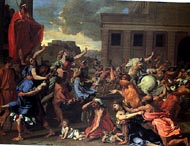 "not as they really happened, but as they would have happened if
nature was perfect." Similarly, in his discussion of Bernini's sculpture
"not as they really happened, but as they would have happened if
nature was perfect." Similarly, in his discussion of Bernini's sculpture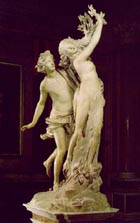 ,
Anthony Janson characterizes Apollo's actions as "amorous advances."
But is this Daphne's point of view? In fact, Bernini constructs Daphne as
frightened; she cries out and tries to escape. Janson, like so many other
writers, ignores this aspect of the work.
,
Anthony Janson characterizes Apollo's actions as "amorous advances."
But is this Daphne's point of view? In fact, Bernini constructs Daphne as
frightened; she cries out and tries to escape. Janson, like so many other
writers, ignores this aspect of the work.
Is the Victim Willing?
Art historians sanitize "heroic" rape scenes by depicting the victim as willing. This idea stems from classical culture. Amy Richlin has shown that Ovid in the Ars Amatoria "illustrates his contention that no means yes." Ovid writes " You may call it vis [rape/force]; that is vis is pleasing to girls; ...a woman who has departed untouched, when she could have been forced, though she simulates gladness with her face, will be sad.
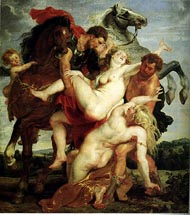 Sounding like defense attorneys
in a rape trial, de la Croix and Tansey note that in Ruben's Daughters
of Leucippus "the maidens [do not] energetically resist." Hartt
similarly describes Europa as "distraught yet yielding." Panofsky
and Rosan repeat Ellis Waterhouse's remark that Europa is displaying her "charms."
Panofsky adds that the "postion of her body suggests surrender as well
as fear, so does the action of her arms suggest as embrace...."
Sounding like defense attorneys
in a rape trial, de la Croix and Tansey note that in Ruben's Daughters
of Leucippus "the maidens [do not] energetically resist." Hartt
similarly describes Europa as "distraught yet yielding." Panofsky
and Rosan repeat Ellis Waterhouse's remark that Europa is displaying her "charms."
Panofsky adds that the "postion of her body suggests surrender as well
as fear, so does the action of her arms suggest as embrace...."
/p. 34: But should we too accept this sanitization of "heroic" rape imagery? Or should we question whether the Greco-Roman gods and heroes acted heroically? Erwin Panofsky and Fritz Saxl have written that "medieval Wester art was unable, or, what comes to the same thing, was unwilling, to retain a classical prototype without destroying either its original form, or...its original meaning." Indeed, Italian Renaissance art, did at times retain classical ideas about rape. But many of these ideas are unacceptable to us today --that sexual relations are likew the hunt, that rape is a crime of property, that women often really want rape, that when the rapist is hero, the victim will feel only glorious rapture. Unfortunately, many art historians do not distance themselves from these ideas and so /p.35: appear to support them --in fact, at times, scholars invoke classical ideas even when these are not found in the works that they are discussing. Recently the solicitor-general of Scotland declared that "it is part of the business of men and women that they hunt and are hunted, and say "yes" and "no" and mean the opposite." Early modern images of "heroic" rape often express such ideas, but we, at the close of the twentieth century, need not.
